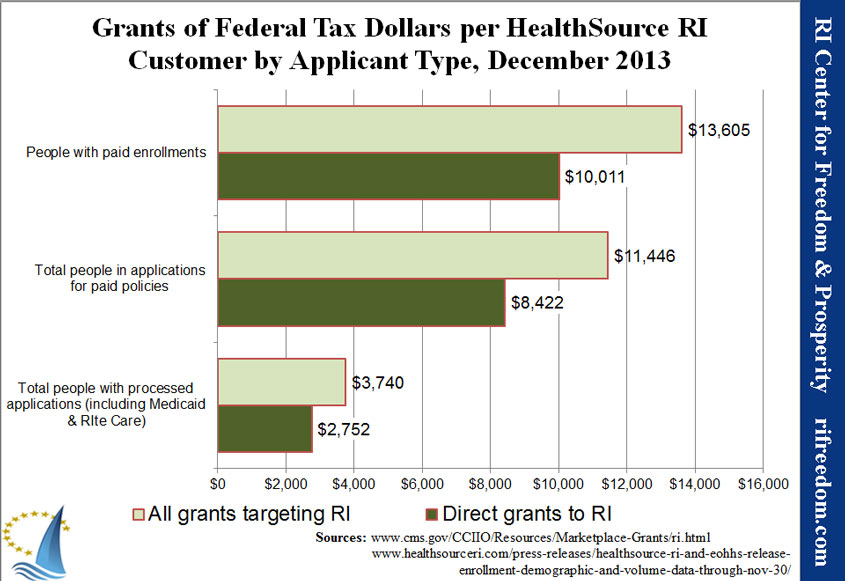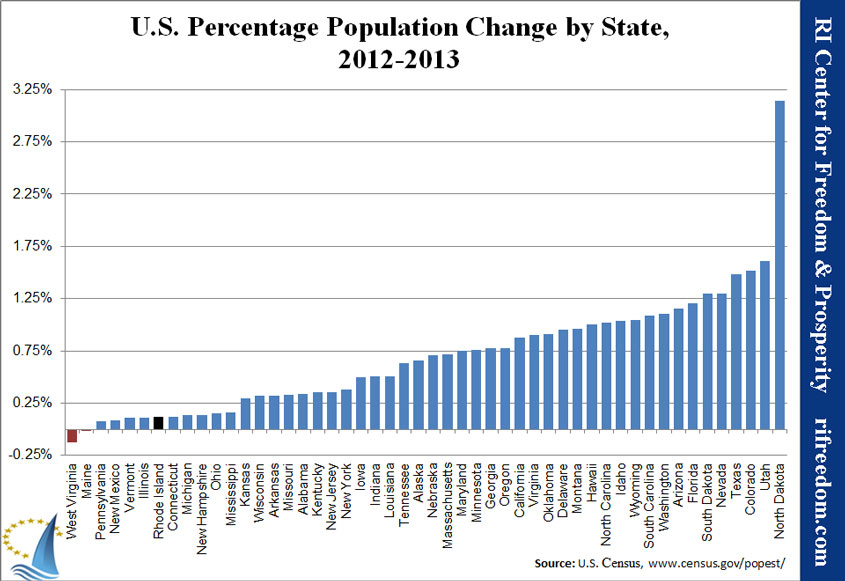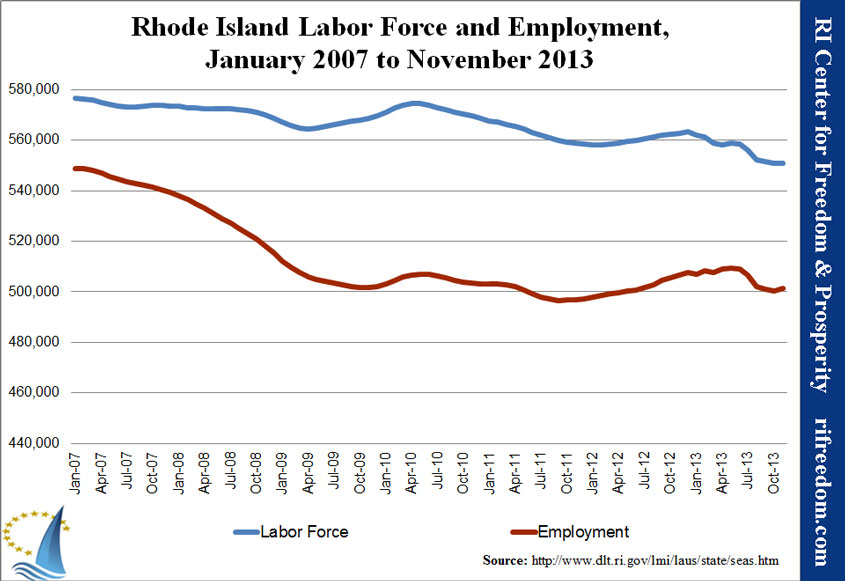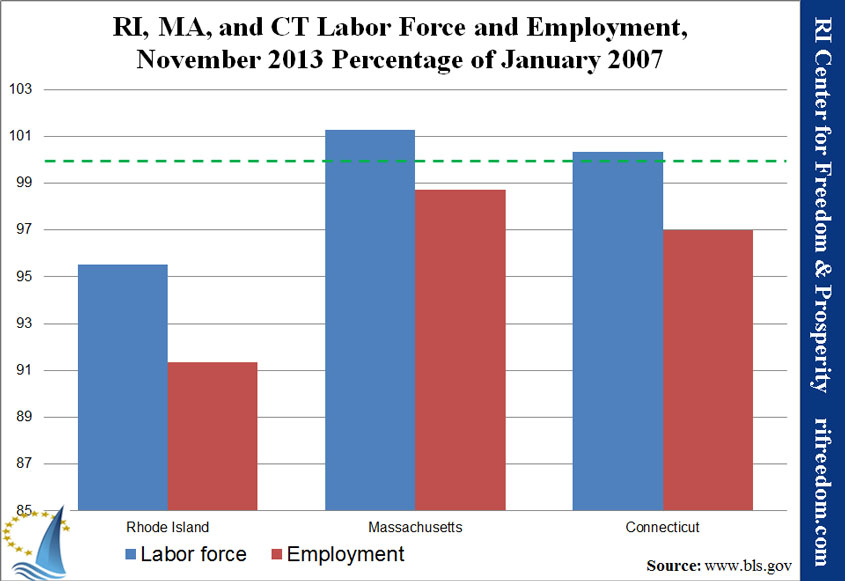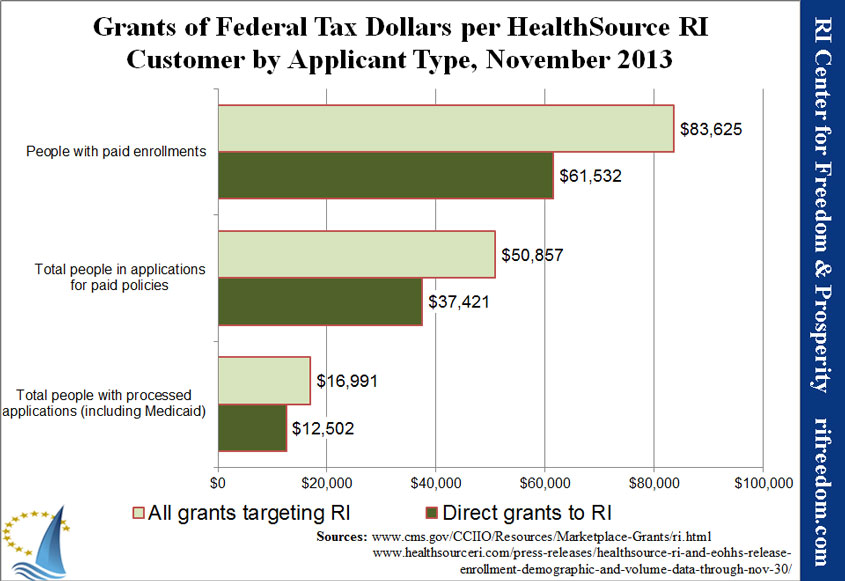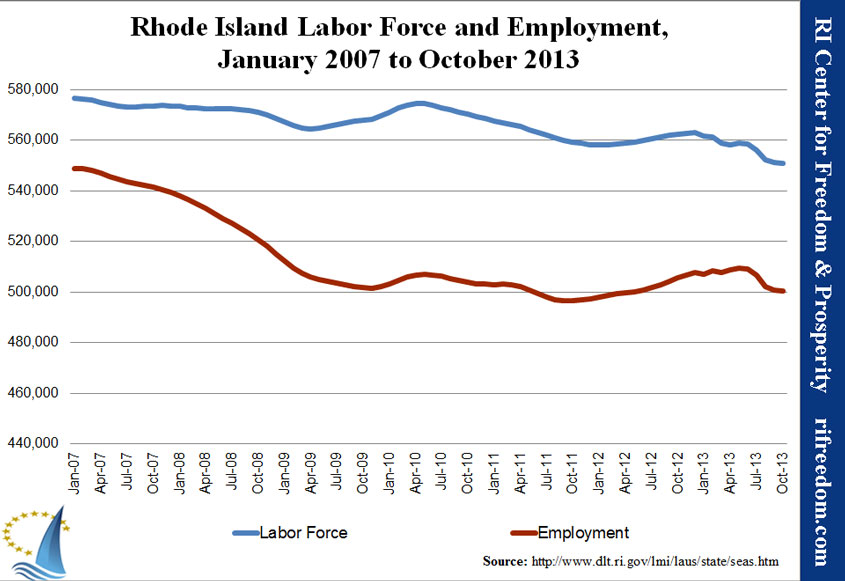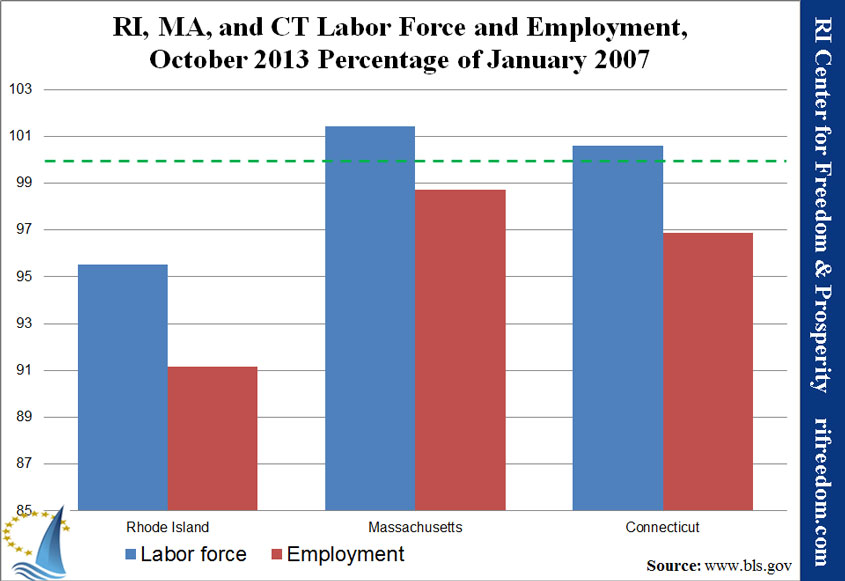At the December 3rd hearing of the Joint Legislative Commission to Study Repeal of the Sales tax, the Rhode Island Center for Freedom and Prosperity defended the projections in its original Zero.Zero Sales Tax Report by the STAMP model, and also questioned the underlying assumptions of the REMI model used by the Rhode Island Department of Revenue to question those findings.
The Center is not alone in sharing its concerns about the REMI tool, a two prominent organizations have also published related papers:
- The second paper – BHI on Modeling State Tax Policy – was created by the head of the Beacon Hill Institute, which developed the STAMP model. A PHD economist and professor at Suffolk University, Dr. David Tuerck discusses the appropriateness of modeling state tax policy on “Keynsian” economic theories, theories that government spending is a spur to consumption, as opposed to the “classical” model, which believes that government spending inhibits savings and investment.
- (Update May 2014: On May 21, 2014, The Institute on Taxation and Economic Policy (ITEP) released a report entitled, “STAMP is an Unsound Tool for Gauging the Economic Impact of Taxes” The report makes several criticisms of the Beacon Hill Institute (BHI) State Tax Analysis Modeling Program (STAMP®). In the following link, BHI responds to the criticisms contained in the Executive Summary of the report. Response to ITEP Critique )
The full related testimony at that hearing of Mike Stenhouse, CEO for Center, is below.
December 3, 2013
TO: Joint Sales Tax Study Commission #6
FROM: Mike Stenhouse, CEO
SUBJECT: Prepared Testimony Remarks
Mr. Chairman, Commission members – good to be back with you.
Today, I have two topics to cover. First, some comments on the economic modeling tool issue that was the subject of Paul Dion’s testimony. Second, as requested by Chairman Malik and other commission members, I’d like to review our Center’s new report displaying projections, from alternative sales tax reduction scenarios that we ran through the STAMP model.
Now, with regard to comparing economic modeling tools, I’d like to take a (more) results oriented, practical and empirical angle (vs Mr. Dion’s more technical analysis). If I may paraphrase Joe Henchman from the Tax Foundation in his testimony at the last Commission hearing … no model is 100% accurate, and the differences in the underlying assumptions of the models are vital to understand.
Let me first take a step back and remind you of some of the arguments that our Center – and others who have testified before this Commission – have been making. In summary,
- The status quo is not adequately serving our state, we are not competitive with other states, and the need for bold action as part of a new public policy approach is required if we are to keep pace
- The current spend and tax public policy culture – of government trying to serve the needs of too many at the expense of a growth economy – should be revisited; basically, that our state government is trying to do too much, with too small a tax base.
Our Center always knew that, ultimately, this sales tax debate, would lead to a larger, philosophical public policy discussion: Is our current approach working? If not, what underlying policy approach should our state adhere to instead? Indeed, the sales tax repeal issue before this Commission cannot ultimately be decided without considering the higher philosophy towards public policy.
The two economic modeling tools in question – REMI, used by the state; and STAMP, the model our Center has used in making its projections – as it turns out, represent a very similar philosophical challenge.
While we largely agree with Paul Dion’s testimony about the significant differences between the two models, it is unfortunate that members from the STAMP team are not hear today to refute, what we believe, were a number of mis-characterizations of the STAMP model by Mr. Dion. It is not the purpose of my testimony, nor is it within my skill set, to attempt to provide such rebuttals myself.
First, I’d like to echo thanks to Chairman Malik, the State Department of Revenue staff, the REMI staff, the STAMP staff at the Beacon Hill Institute who hosted us, John Simmons from RIPEC , and our staff for taking the time to look under the hood in attempting to compare these two models.
In the end (as Paul Dion has testified), here’s where we stand today: two models, two widely varying underlying assumptions, and two very different projections … so what’s a Commission member to make of it? One model assumes at its core that “government spending” provides a greater local economic impact than does “private spending”. The other model assumes the exact opposite.
Our Center is not alone in expressing the concerns we will discuss with you today about the REMI tool. In the next day or so, we will post on our website two papers that further discuss these modeling differences:
- The first paper, published by the Cato Institute some years ago, discussed what it calls the “Misuse of Regional Economic Models” … like REMI.
- The second paper was created just this week by the head of the Beacon Hill Institute, which developed the STAMP model. A PHD economist and professor at Suffolk University, Dr. David Tuerck discusses the appropriateness of modeling state tax policy on “Keynsian” economic theories, theories that government spending is a spur to consumption, as opposed to the “classical” model, which believes that government spending inhibits savings and investment.
This is the core of the debate, when considering these two modeling tools. And, let me say up front that there is no right or wrong answer that applies to all states. Different modeling tools based on differing economic assumptions may produce different projections in different states at different points in time based on differing fundamentals of their highly differentiated state economies.
But there is one critical and important question you should continually ask yourselves as you consider a course of action to recommend: in our state, in Rhode Island, is the status quo working for us? And should a modeling tool that supports the status quo be a factor in your determination of whether or not you will support significant sales tax reform?
The REMI model tends to show an economic benefit if we continue the high tax, high spending formula our state has deployed over the past decade or more. In fact, it would show that increasing government spending would be good for our economy.
Again apply the question: how has that spending formula been working out for Rhode Island lately?
The REMI model would similarly show that cutting government spending via tax cuts would be harmful to the economy. But, this is not what you’ve been hearing from the experts who have previously testified before you.
The STAMP model assumes the opposite: that government spending has the effect of “crowding out” the more vital private consumption … by affecting incentives to work, save, and invest. That lower levels of taxes and spending would, conversely, be good for our state’s economy. Clearly, a different approach.
Ask yourself a variation of the question: does RI’s economy need a tax policy change?
Let me give you a telling example. These differing philosophies and models can simply be explained by a discussion we had during our meeting in Boston a few weeks ago. We were discussing how STAMP showed that a 0.0% sales tax, with associated government spending cuts, would dramatically boost the economy via the benefits we’ve already put forth to this commission … and how REMI, conversely, projected a negative impact because of the reduced levels of government spending. I then asked the REMI representatives what the REMI model would show if, instead of reducing the sales tax by 7% to zero, the RI sales tax were to be raised by 7% to 14%, with all of that extra revenue collected to be spent by the state government. They replied that the REMI model would show a “positive” net impact for the economy.
Let me repeat, the REMI model would predict that doubling the sales tax would be good for Rhode Island. How many of you believe that would be the case? Isn’t this the same approach that has turned our Ocean State into one of the highest taxed, lowest performing states in the country?
Again, the important point is that, in our state, in Rhode Island, the status quo pattern of ever increasing government spending and taxation is not working for us!
You all already know –ad nauseum – about the persistent near last place rankings of our state. About families struggling and leaving town because of oppressive levels of taxation, and a lack of opportunity.
And remember that during the course of these hearings you have heard testimony about economic philosophies, from a national tax expert about the need for our state to become more competitive and to be known for something, about modeling projections that show enormous potential job growth, empirical data about how a zero sales tax state such as NH has won billions of dollars in retail sales from its VT and ME neighbors, research about how RI’s border population is more dense and more wealthy than NH’s (indicating that repeal of the sales tax might have an ever greater positive effect in RI), and you heard anecdotal evidence from person after person, student after student, family member after family member, and business owner after business owner, how repeal of the sales tax, and lower tax burdens overall, would be a help to their family finances and business prospects …
… that the status quo is the enemy of their futures.
Yet the REMI model, which in our view is symbolic of the status quo tax and spend approach, suggests we ignore this evidence and trust that more of the same is the answer for our state. I concede that that model and that philosophy may work in some states, but it is up to you – and this Commission – to determine if continuing this status quo philosophy is ever going to work for OUR state.
In fact, even State Tax Administrator, David M. Sullivan, said last week in the ProJo that the recent liquor/wine tax cuts should help to spur sales and boost the state’s economy at an important time for retailers. How does this statement square with the opposite findings of the department own REMI tool?
The STAMP model, the basis for the projections in our original Zero.Zero report and for the new projections I’ll soon share with you, provides a direct alternative to the status quo. Admittedly, and as Paul Dion has pointed out, the two models employ a dramatically different philosophical approach.
It is the job of this commission to determine if a tax policy change is needed. And, inevitably, this means that you must also endorse a specific economic philosophy. Does Rhode Island need a new approach?
If yes, and you believe the status quo is not acceptable, then we suggest that a modeling tool that places a premium on that new approach should be your guide – the STAMP model that our Center entrusts.
If not, and you believe that our state should continue with its status quo tax and spend policies, then you should continue to be guided by the state’s REMI model.
Allow me to present one other, we think, indisputable argument as to why you may choose to give more credence to the STAMP model: the report card our Center published shows that RI is the #1 state in the country when it comes to “income redistribution”: In other words, the highest level of government spending on certain groups, after collecting taxes from other groups. If government spending is indeed a stimulus to a state’s economy, as REMI assumes, and if RI has been doing this at a higher level than any other state, then it would stand to reason that we should have the nation’s best economy. Right? However, the vast majority of data indicates that the exact opposite is true.
In fact, in our state, in Rhode Island, some of the highest levels of government spending in the nation have led to one of the worst performing state economies in the nation. (Why would this Commission, or the General Assembly, turn away from a pro growth idea like repealing the sales tax, because of projections from a model that not only supports continued government spending, but actually projects that more of this failed medicine is the cure? It simply does not add up, at least in our state.)
To quote the Beacon Hill paper: The view that the path to economic expansion lies in combined spending and tax increases certainly does not fit the facts at the state level.
So let me conclude this portion of my testimony by reiterating that ultimately, this Commission’s recommendation about reforming the sales tax, will in essence, be a recommendation about whether or not you believe more government spending or more private spending is best; and whether or not our state should embark on a new policy path towards its future prosperity.

